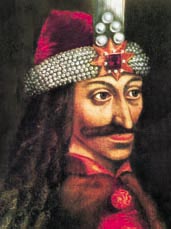| ||
| A group of Wallachian noblemen bringing with them a princely sceptre made most people living Nurnberg, the city of imperial diets, defy the cold weather and take part, on February 8, 1431 in an important hystorical event: emperor Sigismund of Luxembourg conceded the rulership in Wallachia to Vlad who had been living at his court for eight years. That very day, emperor Sigismund gave his favourite a necklace and a golden medallion with a dragon engraved on it, the badge of knights of the Order bearing the name of mystical animal.
Waiting for the coronation, Vlad and his family went to Sighisoara, Transylvania, where he set up a mint. For the first two monetary emission, Vlad used his signet emblem, the dragon. Therefore, the Romanians whose word stock is mainly Latin, nicknamed him Dracul-Dracula (from the Latin DRACO-ONIS). In Romanian Drac means Devil. This nickname turned into a surname for his descendants, Vlad, his second son being known as such. He spent his childhood in Sighisoara, was taken hostage by the Turks, then went to his uncle in Moldavia, and to the Hungarian regent's court Iancu de Hunedoara, a Romanian nobleman (whose daughter Vlad later married) becoming prince of Wallachia on August 22, 1456. Known as one of the most dreaded enemies of the Ottoman Empire, Vlad Dracula started organising the state, the army, the law, applying death penalty by impaling al those he considered enemies: highwaymen, robbers, beggars, cunning priests, treacherous noblemen, usurper Saxons, who tried to replace him either by his cousin Dan the Young or by his natural brother Vlad the Monk. The Ottoman historians nicknamed him Vlad Tepes, as he came to be known in Romanian historiography, but he used to sign with his father's name, Dracula. Back to the throne in 1476 with the help of Stephen the Great, prince of Moldavia, of the Senate of the Republic of Venice and of the pope Sixt 4th, Vlad resumes his fight against the Ottomans but towards the end of the same year he is killed at Snagov by Laiota Basarab who followed him to the throne of Wallachia. | ||
| Back Transylvania |

